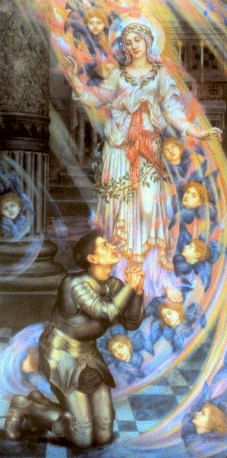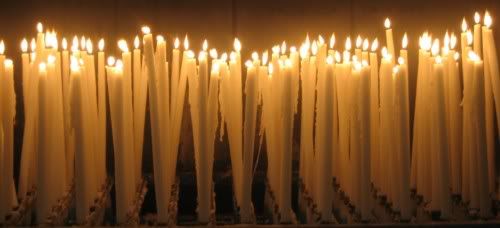The history of devotion to Mary, Our Lady of Ransom, begins with Saint Peter Nolasco. Born in Languedoc in 1189, Saint Peter entered religious life at 25, and devoted himself to acts of charity. Given the historical backdrop at the time, when many Christian soldiers and faithful had been captured by the Moors and were being held in prison, Saint Peter began establishing an Order that would focus on the ransom and redemption of captives—what would become the Mercedarian Order
On August 1, 1218, Our Blessed Mother appeared to Saint Peter, to his confessor, Saint Raymund of Pennafort, and to the king, and through these three servants of God gave weight and approval to the Order that Saint Peter had conceived, establishing a work of the most perfect charity, the redemption of captives.
 Our Blessed Mother first appeared to Saint Peter, declaring that she desired the establishment of a religious order bearing the name “Her Mercy.” As instructed by the Blessed Virgin, the order would deliver captives, and if needed, offer themselves in their place. Both Saint Raymund of Pennafort and the king of Aragon, James I, had similar visions, establishing Saint Peter Nolasco as the founder of this order.
Our Blessed Mother first appeared to Saint Peter, declaring that she desired the establishment of a religious order bearing the name “Her Mercy.” As instructed by the Blessed Virgin, the order would deliver captives, and if needed, offer themselves in their place. Both Saint Raymund of Pennafort and the king of Aragon, James I, had similar visions, establishing Saint Peter Nolasco as the founder of this order.  According to the Constitutions, Mercedarians were 'to visit and to free Christians who are in captivity and in power of the Saracens or of other enemies of our Law… By this work of mercy… all the brothers of this Order, as sons of true obedience, must always be gladly disposed to give up their lives, if it is necessary, as Jesus Christ gave up His for us.' This is known as the Fourth Vow of the Order, in addition to poverty, chastity and obedience of the Augustinian Rule.
According to the Constitutions, Mercedarians were 'to visit and to free Christians who are in captivity and in power of the Saracens or of other enemies of our Law… By this work of mercy… all the brothers of this Order, as sons of true obedience, must always be gladly disposed to give up their lives, if it is necessary, as Jesus Christ gave up His for us.' This is known as the Fourth Vow of the Order, in addition to poverty, chastity and obedience of the Augustinian Rule.  Established in Spain, and approved by Pope Gregory IX under the name “Our Lady of Mercy for the Ransom of Captives” (the Mercedarians), the Order spread rapidly due to the watchful grace of Our Blessed Mother. Its growth was increased as the charity and piety of its members was observed; they very often followed Her directive to give themselves up to voluntary slavery when necessary, to aid the good work. Famous among those willing to give themselves up for their captives was Saint Raymond Nonnatus.
Established in Spain, and approved by Pope Gregory IX under the name “Our Lady of Mercy for the Ransom of Captives” (the Mercedarians), the Order spread rapidly due to the watchful grace of Our Blessed Mother. Its growth was increased as the charity and piety of its members was observed; they very often followed Her directive to give themselves up to voluntary slavery when necessary, to aid the good work. Famous among those willing to give themselves up for their captives was Saint Raymond Nonnatus. The development of the order was immediate and widespread throughout France, England, Germany, Portugal, and Spain. As the Moors were driven back, new convents of Mercy were established at Montpellier, Perpignan, Toulouse, and Vich. Columbus brought some members of the Order of Mercy with him to America, and they founded houses in Mexico, Cuba, Brazil, Peru, Chile, and Ecuador, and took an active part in the conversion of the Indians. Toward the end of the 18th century, the Mercedarians erected houses for the training of missionaries, and in the beginning of the 19th century they undertook elementary teaching in their convents. The mother-house is in Rome, Italy.
The development of the order was immediate and widespread throughout France, England, Germany, Portugal, and Spain. As the Moors were driven back, new convents of Mercy were established at Montpellier, Perpignan, Toulouse, and Vich. Columbus brought some members of the Order of Mercy with him to America, and they founded houses in Mexico, Cuba, Brazil, Peru, Chile, and Ecuador, and took an active part in the conversion of the Indians. Toward the end of the 18th century, the Mercedarians erected houses for the training of missionaries, and in the beginning of the 19th century they undertook elementary teaching in their convents. The mother-house is in Rome, Italy.  It is credibly estimated that the Order ransomed 490,736 slaves between the years 1218 and 1632. An even greater achievement was the conversion of thousands in captivity, and steeling them against the sufferings of a cruel martyrdom for the faith. Protestant historian, Bonet-Maury, records that no expedition sent into the Barbary States by the powers of Europe or America equaled "the moral effect produced by the ministry of consolation, peace and abnegation, going even to the sacrifice of liberty and life, which was exercised by the humble sons of Saints John of Martha, Peter Nolasco, and Vincent de Paul."
It is credibly estimated that the Order ransomed 490,736 slaves between the years 1218 and 1632. An even greater achievement was the conversion of thousands in captivity, and steeling them against the sufferings of a cruel martyrdom for the faith. Protestant historian, Bonet-Maury, records that no expedition sent into the Barbary States by the powers of Europe or America equaled "the moral effect produced by the ministry of consolation, peace and abnegation, going even to the sacrifice of liberty and life, which was exercised by the humble sons of Saints John of Martha, Peter Nolasco, and Vincent de Paul." Today, we are called to continue the good work of the Mercedarians, as requested by Our Blessed Mother. We are confronted with the captivity of sin every day—in our own lives, as well as those we come into contact with. Through the spread of our faith, our personal prayers and penances, we ask Our Blessed Mother—Our Lady of Ransom—to ease the sufferings of others, breathing the lightness of freedom into their lives, and casting off the shackles of sin!
Today, we are called to continue the good work of the Mercedarians, as requested by Our Blessed Mother. We are confronted with the captivity of sin every day—in our own lives, as well as those we come into contact with. Through the spread of our faith, our personal prayers and penances, we ask Our Blessed Mother—Our Lady of Ransom—to ease the sufferings of others, breathing the lightness of freedom into their lives, and casting off the shackles of sin!









0 comments:
Post a Comment
Thanks for leaving a comment. If you wish to submit a prayer request, however, please do so above, using the "Contact" tab.